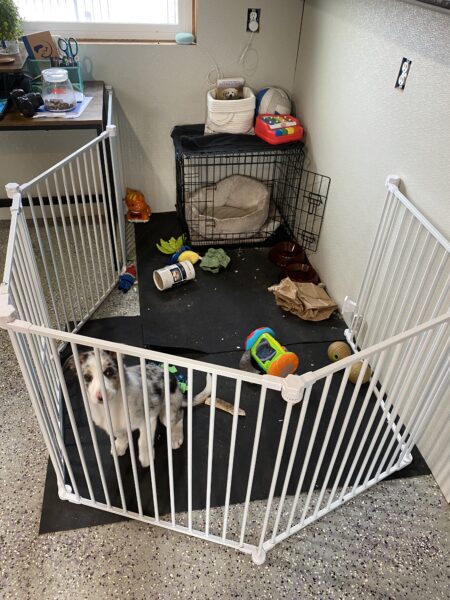For episode 7, Kayla speaks to Sarah Dixon from Barks and Recreation about bringing your puppy home and getting off on the right paw. From the moment you leave the breeder or shelter, you’re starting to teach your puppy about how to live and grow with you. We’ll also cover setting your puppy up for success with a schedule of rest and play that helps everyone out.
Covered in this Episode:
- What you can expect from your puppy behavior-wise in the first few hours or days
- How you can make this transition less stressful for your puppy:
- Bedding from their old home
- DAP – Adaptil
- Puppy palace (photos below)
- Skills to start working on with your new puppy, including:
- Crate
- Housetraining
- Exercise schedule
- House manners – relaxing around the house based on context cues
- Manding – teaching the puppy how to sit and look at us to ask for access to valued items
- Name games
- Capturing attention
- Sit/down/hand targets
- Some things that may be concerning behaviors in a puppy:
- Growling around valued items
- Extreme fear indoors or outdoors; nervous of people; sound sensitivity
- Intolerant or aggressive when being handled
- Panic or frustration/anger when being confined in a pen or crate
- Hyperactive or struggling to settle
- Benefits to creating a schedule for your puppy
- Prevents problems
- Reduces stress and anxiety
- Helps you to know their potty/drink/food schedule
- Example of a Puppy Schedule
- Potty break when they get out of their crate
- Free play (direct attention on your puppy)
- Wind down time
- Tether your dog, or use a pen, provide chews/toys
- If they fall asleep, put them in their crate
- Nap time in crate (provide a meal or puzzle toy)
- Repeat
- Helping your puppy settle/getting them comfy in the crate
- They should settle within five minutes
- Some whining, fussing, and vocalization is normal
- If they are panicking (digging, clawing, biting at bars, loud continual vocalizing) let them out and come up with a plan to try again
- If they are struggling, wait until they are tired before putting them in the crate and sit with them until they fall asleep

We also answer the following Patreon Questions:
- My 14-week old puppy is severely possessive with his food and food bowl. when I go near him and his bowl he doesn’t growl or bite me, he starts eating faster. He also growls and attacks my other dog when he goes near her bowl and/or food.
- My pup has FINALLY figured out how to tell me when he needs to go outside. However, now he has learned to exercise his new power whenever he is bored. How can I teach him that going outside is for potty and not every time the neighbors make a sound?
This podcast is supported by Journey Dog Training and our Puppy Raising Blueprint course. The full course covers topics ranging from common problem behaviors and socialization to the humane hierarchy of dog training. It’s all taught by yours truly, Kayla Fratt. If you need more personalized training support, check out journeydogtraining.com – we have a variety of courses, e-books, and remote training services available. Just check out your options in the menu above.
This podcast is also supported by our members on Patreon. For as little as $3 per month, you can support this podcast and get perks like submitting questions for us to tackle at the end of each episode. Sign up over at patreon.com/pandemicpuppy.
Over the next few episodes, we’ll cover how to pick a puppy from a breeder, selecting a shelter and shelter puppy, and how to prepare for your new puppy!
For Further Reading:
- Surviving the First 24 Hours of Your New Puppy
- Sarah Dixon’s Podcast: Hair of the Dog
- Education for Dog Trainers
- Contact Sarah Dixon
- Need to find a professional dog trainer or behavior consultant near you?

